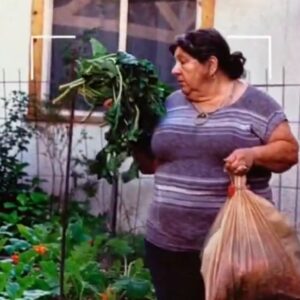This woman had lived on the 8th floor of my building for 50 years. She was always alone, and never smiled. All the neighbors avoided her because she could start a fight at any moment.
Last month, she died. The police knocked on my door, telling me I should go up to her flat with them. As I entered, I got chills: I found my entire childhood drawn in pencil sketches, framed on every wall.
My face as a baby. Me playing in the courtyard with my dog, Toby. My mother holding my hand outside the bakery. All in black and white, but somehow alive with emotion.
They weren’t just pictures—they captured details no one else could’ve known. A scar on my knee from a fall. The yellow ball I refused to let go of, even in sleep.
I stood frozen. “Why are these here?” I asked the officer.
He shrugged. “That’s what we’re trying to figure out. Her name was Clara Dumitrescu. No known family. No one in the building ever really spoke to her, right?”
I nodded slowly. “She was… mean.”
“She left this for you,” he said, handing me an envelope with my name on it. Written in shaky handwriting, but definitely mine.
Back in my apartment, I opened it carefully. Inside was a letter. It read:
“You were the only light I had left. You don’t remember me, but I was once your art teacher, before everything in my life fell apart. You used to sit by the window, drawing birds. You’d always show me your work, proud and hopeful. When your family moved into this building years later, I recognized you immediately. I never said a word because I was ashamed. But I watched you grow, and I drew every part I remembered loving about life. I’m sorry for how I lived. But through you, I felt hope again.”
I had to sit down. I didn’t remember any teacher named Clara, but then again, I was five when I started drawing birds. I called my mom.
She gasped when I told her. “Clara Dumitrescu was your kindergarten art teacher! You adored her. But something happened… her husband died, she left teaching. Nobody heard from her again.”
I never knew. I thought she was just the cranky old woman everyone whispered about. And now I realized, for all these years, she had silently cared. She hadn’t hated us. She had just been… broken.
The next day, I went back to her apartment. The police had left it open for inventory. I wandered through the rooms, and noticed more than just my drawings. There were sketches of others in the building.
The boy from 5B learning to ride his bike. The old couple from 3A sharing soup at sunset. Life scenes, tender and observant. She saw us all, even when we ignored her.
In her closet, I found stacks of notebooks. Page after page of handwritten reflections. Each one dated, each one signed simply “C.” And I started reading.
“March 3rd, 2007 – He waved at me again. The little boy with the scraped knee. I didn’t wave back. I don’t know how. But I smiled, once he turned around.”
It was about me. A child’s small kindness, noticed by someone with a hurting heart.
I read for hours. Her pain was raw, but her words were full of attempts at understanding. It was like she wanted to reconnect, but didn’t know how anymore. And now, she was gone.
I couldn’t sleep that night. Her story haunted me. I had spent years avoiding her, judging her. But she had quietly been watching over all of us. A silent witness to the neighborhood’s tiny joys and tragedies.
The next morning, I brought one of her framed sketches down to the building lobby. The one of the courtyard, full of laughing kids and flying pigeons. I put a note under it: “This was drawn by Clara Dumitrescu. She lived on the 8th floor. She saw us, even when we didn’t see her. Let’s remember her kindness.”
Neighbors started stopping by. First out of curiosity, then something else. Some looked stunned. One man, Mr. Lungu from 6C, wiped a tear and said, “She drew me bringing flowers to my wife when she was sick. I didn’t know anyone saw that.”
More people came. Soon, the lobby turned into a small memorial. People brought candles, more of her sketches, and little notes. Someone printed out parts of her journals and pinned them on the board.
The building felt different. Lighter. Like we had finally opened a window that had been stuck for years.
A week later, something surprising happened. A letter arrived, addressed to “the residents of Bloc 4A.” Inside was a legal notice. Clara had left the building a small inheritance in her will—a trust to be used for “community art, kindness projects, and anything that helps people look up from their phones and see each other again.”
It wasn’t a huge sum, but enough to make a difference. Enough to paint the courtyard walls, fix the benches, and organize an art day for the kids.
I volunteered to coordinate the project. I felt like it was the least I could do. The kids painted flowers and birds. Some drew Clara as a fairy with pencils behind her ear. Even the older neighbors joined in. And for the first time in decades, the building buzzed with something more than complaints and elevator grumbles.
One afternoon, while sorting her things, I found an old photo album. Tucked inside was a picture of her, young and radiant, holding a painting of sunflowers. Next to her was a little girl with two braids—it was me. I stared at the image for a long time, tears welling up.
All this time, she carried that photo. When I had forgotten her, she had remembered me.
A twist came two months later. A woman from the city’s cultural office reached out. Apparently, Clara had once submitted a portfolio for an art grant, back in the 1980s. The committee had misplaced it. It had recently resurfaced, and they wanted to feature her work in a public exhibition titled “Lost Voices of the City.”
They needed permission from her legal heir. Which… was me.
I couldn’t believe it. Clara, the woman everyone avoided, was about to be showcased in a city gallery. I said yes, of course. And I asked if the exhibition could include some of her journals too.
The launch night was packed. People from our building came, and so did strangers who had never met her but were moved by her story. Her drawings hung proudly on the walls—simple, honest depictions of daily life. They weren’t flashy, but they made people cry. Laugh. Think.
At one point, a man walked up to me. Middle-aged, with gray at his temples. “You don’t remember me,” he said softly, “but I was Clara’s nephew. We lost touch decades ago after some family drama. I saw the news about the exhibit… and I just had to come.”
I didn’t know what to say. He looked overwhelmed. “I always thought she hated everyone. But now… I see I was wrong.”
I handed him a copy of the letter she wrote me. He read it slowly, then held it to his chest.
Later that evening, he donated a few of her old paintings he had kept in his attic. “She painted these for my mother. Maybe they belong here now.”
Clara’s legacy grew. A few art schools asked to include her works in their curriculum as an example of “silent storytelling.” Her journals were digitized for public access. And back at our building, we decided to name the courtyard garden after her: “Clara’s Corner.”
Every spring, kids now plant flowers there. Seniors sit and talk. And nobody forgets to wave at each other anymore.
A year passed.
On the anniversary of her death, we held a small event. We shared stories, displayed new art, and invited children to read excerpts from her journals. One boy, barely ten, stood up and read:
“Sometimes love doesn’t look like hugs or words. Sometimes, it looks like a window lit every night, quietly watching you come home safe.”
He didn’t fully understand what he was reading. But we all felt it.
That night, I sat in my apartment, looking out at the glowing courtyard. And for the first time, I didn’t feel guilty. I felt connected. Like Clara had somehow stitched us all back together with pencil lines and quiet glances.
We often judge people based on what little we see. We forget that silence doesn’t always mean anger. That bitterness can grow from heartbreak. And that even the loneliest among us might still be loving us in their own hidden ways.
Clara wasn’t just the woman on the 8th floor. She was an artist, a witness, a soul who fell and tried, in the quietest of ways, to stand back up.
We never thanked her when she was alive. But maybe, just maybe, she knew that someday, we would.
So the next time you see someone who seems cold or distant, remember Clara. And look again.
Sometimes, the kindest hearts are wrapped in silence.
If this story touched you, share it with someone. You never know who might need a reminder that every person has a story—and sometimes, a second look changes everything.





